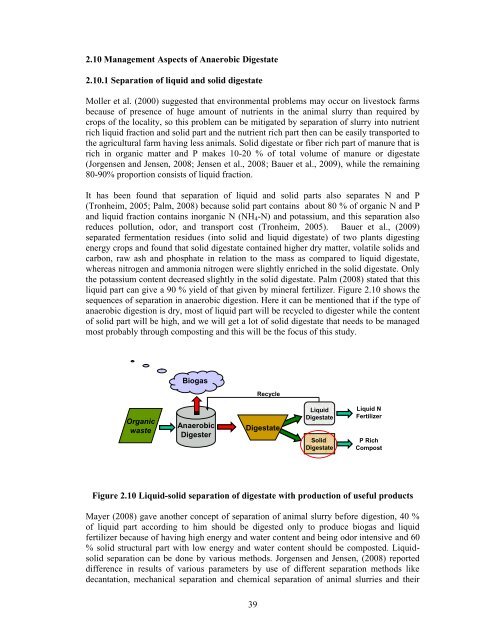dry anaerobic digestion of municipal solid waste and digestate ...
dry anaerobic digestion of municipal solid waste and digestate ...
dry anaerobic digestion of municipal solid waste and digestate ...
Create successful ePaper yourself
Turn your PDF publications into a flip-book with our unique Google optimized e-Paper software.
2.10 Management Aspects <strong>of</strong> Anaerobic Digestate<br />
2.10.1 Separation <strong>of</strong> liquid <strong>and</strong> <strong>solid</strong> <strong>digestate</strong><br />
Moller et al. (2000) suggested that environmental problems may occur on livestock farms<br />
because <strong>of</strong> presence <strong>of</strong> huge amount <strong>of</strong> nutrients in the animal slurry than required by<br />
crops <strong>of</strong> the locality, so this problem can be mitigated by separation <strong>of</strong> slurry into nutrient<br />
rich liquid fraction <strong>and</strong> <strong>solid</strong> part <strong>and</strong> the nutrient rich part then can be easily transported to<br />
the agricultural farm having less animals. Solid <strong>digestate</strong> or fiber rich part <strong>of</strong> manure that is<br />
rich in organic matter <strong>and</strong> P makes 10-20 % <strong>of</strong> total volume <strong>of</strong> manure or <strong>digestate</strong><br />
(Jorgensen <strong>and</strong> Jensen, 2008; Jensen et al., 2008; Bauer et al., 2009), while the remaining<br />
80-90% proportion consists <strong>of</strong> liquid fraction.<br />
It has been found that separation <strong>of</strong> liquid <strong>and</strong> <strong>solid</strong> parts also separates N <strong>and</strong> P<br />
(Tronheim, 2005; Palm, 2008) because <strong>solid</strong> part contains about 80 % <strong>of</strong> organic N <strong>and</strong> P<br />
<strong>and</strong> liquid fraction contains inorganic N (NH 4-N) <strong>and</strong> potassium, <strong>and</strong> this separation also<br />
reduces pollution, odor, <strong>and</strong> transport cost (Tronheim, 2005). Bauer et al., (2009)<br />
separated fermentation residues (into <strong>solid</strong> <strong>and</strong> liquid <strong>digestate</strong>) <strong>of</strong> two plants digesting<br />
energy crops <strong>and</strong> found that <strong>solid</strong> <strong>digestate</strong> contained higher <strong>dry</strong> matter, volatile <strong>solid</strong>s <strong>and</strong><br />
carbon, raw ash <strong>and</strong> phosphate in relation to the mass as compared to liquid <strong>digestate</strong>,<br />
whereas nitrogen <strong>and</strong> ammonia nitrogen were slightly enriched in the <strong>solid</strong> <strong>digestate</strong>. Only<br />
the potassium content decreased slightly in the <strong>solid</strong> <strong>digestate</strong>. Palm (2008) stated that this<br />
liquid part can give a 90 % yield <strong>of</strong> that given by mineral fertilizer. Figure 2.10 shows the<br />
sequences <strong>of</strong> separation in <strong>anaerobic</strong> <strong>digestion</strong>. Here it can be mentioned that if the type <strong>of</strong><br />
<strong>anaerobic</strong> <strong>digestion</strong> is <strong>dry</strong>, most <strong>of</strong> liquid part will be recycled to digester while the content<br />
<strong>of</strong> <strong>solid</strong> part will be high, <strong>and</strong> we will get a lot <strong>of</strong> <strong>solid</strong> <strong>digestate</strong> that needs to be managed<br />
most probably through composting <strong>and</strong> this will be the focus <strong>of</strong> this study.<br />
Organic<br />
<strong>waste</strong><br />
Biogas<br />
Anaerobic<br />
Digester<br />
Digestate<br />
39<br />
Recycle<br />
Liquid<br />
Digestate<br />
Solid<br />
Digestate<br />
Liquid N<br />
Fertilizer<br />
P Rich<br />
Compost<br />
Figure 2.10 Liquid-<strong>solid</strong> separation <strong>of</strong> <strong>digestate</strong> with production <strong>of</strong> useful products<br />
Mayer (2008) gave another concept <strong>of</strong> separation <strong>of</strong> animal slurry before <strong>digestion</strong>, 40 %<br />
<strong>of</strong> liquid part according to him should be digested only to produce biogas <strong>and</strong> liquid<br />
fertilizer because <strong>of</strong> having high energy <strong>and</strong> water content <strong>and</strong> being odor intensive <strong>and</strong> 60<br />
% <strong>solid</strong> structural part with low energy <strong>and</strong> water content should be composted. Liquid<strong>solid</strong><br />
separation can be done by various methods. Jorgensen <strong>and</strong> Jensen, (2008) reported<br />
difference in results <strong>of</strong> various parameters by use <strong>of</strong> different separation methods like<br />
decantation, mechanical separation <strong>and</strong> chemical separation <strong>of</strong> animal slurries <strong>and</strong> their

















